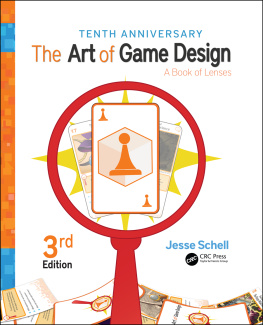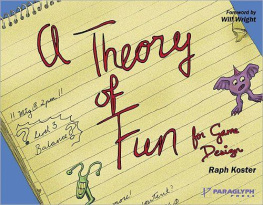100 Principles of Game Design
Wendy Despain, Editor
Keyvan Acosta
Liz Canacari-Rose
Michael Deneen
Zach Hiwiller
Jeff Howard
Christina Kadinger
Chris Keeling
Casey Kuczik
Nicole Lazzaro
Tom Long
Michael Lucas
Dave Mark
Douglas Oberndorf
Patricia Pizer
Michael Pynn
Brian Stabile
Jason Vandenberghe

100 PRINCIPLES OF GAME DESIGN
Wendy Despain, Editor
New Riders
www.newriders.com
To report errors, please send a note to
New Riders is an imprint of Peachpit, a division of Pearson Education.
Copyright 2013 Wendy Despain
Senior Editor: Karyn Johnson
Copy Editor: Rebecca Rider
Production Editor: David Van Ness
Proofreader: Scout Festa
Illustrator: Ray Yuen
Composition: Danielle Foster
Indexer: Valerie Perry
Cover design: Aren Straiger
Interior design: Claudia Smelser
Cover photo: www.studiodespain.com
Contributors: Wendy Despain, Keyvan Acosta, Liz Canacari-Rose, Michael Deneen, Zach Hiwiller, Jeff Howard, Christina Kadinger, Chris Keeling, Casey Kuczik, Nicole Lazzaro, Tom Long, Michael Lucas, Dave Mark, Douglas Oberndorf, Patricia Pizer, Michael Pynn, Brian Stabile, Jason VandenBerghe
Notice of Rights
All rights reserved. No part of this book may be reproduced or transmitted in any form by any means, electronic, mechanical, photocopying, recording, or otherwise, without the prior written permission of the publisher. For information on getting permission for reprints and excerpts, contact .
Notice of Liability
The information in this book is distributed on an As Is basis, without warranty. While every precaution has been taken in the preparation of the book, neither the author nor Peachpit shall have any liability to any person or entity with respect to any loss or damage caused or alleged to be caused directly or indirectly by the instructions contained in this book or by the computer software and hardware products described in it.
Trademarks
Many of the designations used by manufacturers and sellers to distinguish their products are claimed as trademarks. Where those designations appear in this book, and Peachpit was aware of a trademark claim, the designations appear as requested by the owner of the trademark. All other product names and services identified throughout this book are used in editorial fashion only and for the benefit of such companies with no intention of infringement of the trademark. No such use, or the use of any trade name, is intended to convey endorsement or other affiliation with this book.
ISBN-13: 978-0-321-90249-8
ISBN-10: 0-321-90249-1
9 8 7 6 5 4 3 2 1
Acknowledgments
A ton of thanks need to be heaped into three piles, so in no particular order, I would like to acknowledge that our inspiration for this book is another book used the world over by great game designers; it is called Universal Principles of Design, by William Lidwell, Kritina Holden, and Jill Butler. So many great game designers I know count this as a valuable part of their professional library.
However, when we started introducing this book to students in the Game Design program at Full Sail University, we discovered that this classic was in some ways too advanced for them. Their inexperience made it too hard for them to make the leap from architecture or art to game design. We initially tried to write a book that bridged the gap between these wider, classic universal principles and the process of game design. But we soon found that we wanted to add a few game-design-specific principles here and there. And then we found that a few had turned into 85 or so, and there was no end in sight. So now there are a few principles in this book that are also covered in Universal Principles of Design, but not very many. In my opinion, these two books are great companions on the bookshelf of any game designer.
And the next acknowledgment goes to the person who deserves undying thanks and delicious home-made baked goods every holiday for the foreseeable future. Ray Yuen, the illustrator, who I swear has a collection of gnomes under his back porch sketching adorable, funny characters doing wacky things like bringing a gun to a knife fight, did great things for this book in an insanely short amount of time and did an admirable job of adding zombies. Thanks, Ray. I hope you share the cookies with the gnomes.
And third, but not last, is the long list of contributors who went off this cliff with me. Thanks so much, everybodyyou know what for. Specifically, I think Keyvan Acosta gets credit for the original idea for this book, Chris Keeling gets credit for being a temporary figurehead, and Ricardo Aguilo gets credit for being with us in spirit but having finally learned how to say no when asked to volunteer for something. Id better stop now before I get any more teary-eyed about all the great contributors (and the amazingly wonderful editor at New Riders, Karyn Johnson, who tells me I have no more room on the page). So Ill just say I love every one of you, and your baked goods are in the oven right now.
The 100 Principles: An alphabetical listing
Introduction
This book is a toolbox of possibilities. It is not a how-to manual. It contains at least four principles (Im not telling which ones) that insist or imply there is only one true way to begin designing a game, and if it is started in any other way disaster will ensue. They cannot all be right... can they?
Well, Im sure I dont know, and Im not going to try to convince you one way or the other either. What I do know is that these ways/principles/philosophies are all coexisting in the current game industry. Different companies, rock-star designers, and schools of thought all use them and swear by them. Maybe theres a Masters thesis in there somewhere, but Im not interested in digging it out and ranking the schools of thought according to some value of success.
Im a collector, not a competitor. I go through life picking up ideas and adding them to my mental list of Hey, thats interesting, I might use it someday. And when I stumbled into game design as a profession, I discovered every game designer does this same thing. They have a mental toolbox they have collected over the years, which they bring to bear on whatever problem faces them.
And this is one of the reasons it is so hard to teach game design. The tools of the trade are vast and strange. This book is a download of my own mental toolbox with additions from the collections of my professional colleagues. I find it liberating and exciting to have it out in front of me instead of floating around in a jumble in my grey matter. Its even organized into the four times I find myself reaching for these tools: when Im trying to innovate, when Im hacking out the cruft in the middle of game creation, when the nearly finished work has to be balanced, and ultimately whenever I have to troubleshoot a specific problem.
How This Book Is Organized
Did I just make a book that needs its own instruction manual? I think I did. Im not sure if this is a good thing or not! Its certainly very meta. The fact is, this isnt like any other game design book out there, so maybe you do need a bit of help text up front to get you oriented (see ).
This book is riddled with phrases highlighted in orange type (like the one in the previous sentence) that reference other principles of game design. If they look a bit like web links, its because thats what I wish they were. I wish you could poke them with your finger and have the pages turn to show you that theres a whole section right over there expanding on this idea. Maybe the digital version will work that way one day.






![Jesse Schell [Jesse Schell] - The Art of Game Design, 2nd Edition](/uploads/posts/book/119435/thumbs/jesse-schell-jesse-schell-the-art-of-game.jpg)
![Wagner James Au [Wagner James Au] - Game Design Secrets](/uploads/posts/book/119431/thumbs/wagner-james-au-wagner-james-au-game-design.jpg)
![Ethan Ham [Ethan Ham] - Tabletop Game Design for Video Game Designers](/uploads/posts/book/119417/thumbs/ethan-ham-ethan-ham-tabletop-game-design-for.jpg)



